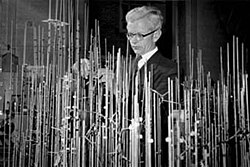John Kendrew
Wikipediasta
| John Kendrew | |
|---|---|
 |
|
| Henkilötiedot | |
| Syntynyt | 24. maaliskuuta 1917 Oxford, Iso-Britannia |
| Kuollut | 23. elokuuta 1997 (80 vuotta) Cambridge, Iso-Britannia |
| Kansalaisuus |
|
| Koulutus ja ura | |
| Tutkinnot | Cambridgen yliopisto |
| Väitöstyön ohjaaja | Max Perutz |
| Oppilaat | Peter Pauling |
| Tutkimusalue | Biokemia |
| Tunnetut työt | Hemiryhmän sisältävien proteiinien tutkimus |
| Palkinnot |
|

John Cowdery Kendrew ( 24. maaliskuuta 1917 Oxford – 23. elokuuta 1997 Cambridge) oli brittiläinen biokemisti. Hän sai Nobelin kemianpalkinnon vuonna 1962 myoglobiinin ja muiden proteiinien rakenteiden selvittämisestä. Hän jakoi palkinnon Max Perutzin kanssa.
Kendrew valmistui Cambridgen yliopistosta vuonna 1939. Toisen maailmansodan ensimmäisten kuukausien aikana hän tutki kemiallisten reaktioiden kinetiikkaa ja myöhemmin hän työskenteli tutkien parissa. Sotavuosien aikana Kendrew kiinnostui biokemiallisista ongelmista ja päätti ryhtyä tutkimaan proteiinien rakenteita.
Kendrew tapasi vuonna 1945 Max Perutzin Cambridgessä. Fysiologi Joseph Barcroft oletti, että Kendrew pystyisi tekemään kristallografisia tutkimuksia proteiineille kuten hemoglobiinille ja Kendrew aloitti tutkimukset. Vuonna 1947 Kendrew selvitti myoglobiinin rakenteen.
Myöhemmin Kendrew oli muun muassa perustamassa Euroopan molekyylibiologian järjestöä EMBOa ja toiminut British Museumin johtokunnan jäsenenä.
Aiheesta muualla
[muokkaa | muokkaa wikitekstiä]
| ||||||||||||||||||||||
Text is available under the CC BY-SA 4.0 license; additional terms may apply.
Images, videos and audio are available under their respective licenses.
